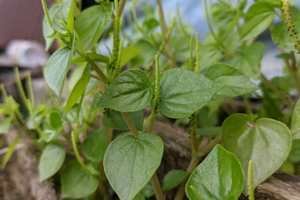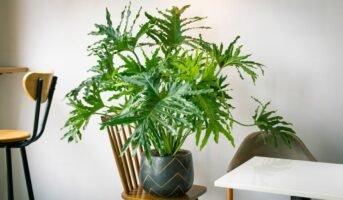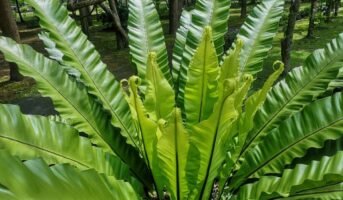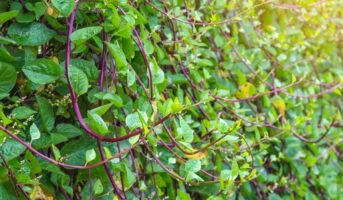The Peperomia plant or the Padiator Plant, scientifically known as Peperomia Pellucida, is a species of plants that belong to the Piperaceae family. It is the choice for many house owners that are going for a minimalistic, clean look and don’t have a lot of time on their hands. It is super easy to look after and doesn’t have flowers. It instead has beautiful, lush green leaves and small pale green spikes on its stems. Native to Asia and America, it is mostly found in humid, moist climates and tropical habitats.
The peperomia family consists of 1500 different species that are similar but also can be differentiated based on appearances, the most common being the Peperomia pellucida, which is grown as a compact houseplant and goes great with minimalistic backdrops. The varieties can be differentiated by their foliage which tends to differ ever so slightly with each variant. These plants require little to no effort at all and tend to grow slowly.

Source: Pinterest
Peperomia Pellucida: Quick facts
| Common names | Peperomia, radiator plant, shiny bush, Vietnamese crab claw, rat ear |
| Family | Piperaceae |
| Plant type | Herbaceous, perennial |
| Mature size | 6-12 in. tall, 6-12 in. wide |
| Sun exposure | Partial |
| Soil type | Loamy, well-drained, moist |
| Soil pH | Acidic, neutral |
| Bloom time | Summer |
| Flower colour | White, green |
| Native areas | Central America, south America |
Peperomia pellucida: Types of peperomia
One of the reasons that make this plant very popular amongst fellow anthophiles is the fact that there are over 1500 variants, which have subtle but still contrasted differences, most notable being the various forms of leaves. Some of the most sought-after variants include:
-
Peperomia caperata:
The most popular member of the peperomia family in this list; it features wrinkled, slightly heart-shaped leaves with subtle hues of red, orange or purple and dark veins.

Source: Pinterest
-
Peperomia argyreia:
Also known as the watermelon peperomia, this species features oval-shaped leaves with a silvery pattern running through them. It does exceptionally well in containers.

Source: Pinterest
-
Peperomia obtusifolia:
This plant grows upright and has dark green leaves, which are usually rounded.

Source: Pinterest
-
Peperomia rotundifolia:
this member of the peperomia family is a trailing plant with small round leaves.

Source: Pinterest
Peperomia Pellucida: How to grow?
The peperomia plant thrives best when slightly potbound. Choose a pot that fits only the root ball and repot the plant every 2-3 years, and try going up a size if the roots have grown. Maintain adequate moisture, and don’t allow it to dry out. For the soil, a 50:50 mixture of peat moss and perlite should be used. Throw some gravel in if you’re feeling too affectionate. It airs the roots and prevents them from suffocating. Ideally, you should plant them at the start of spring.
The Pellucida does not beg for a ton of light for its growth and generally prefers an ample amount of shade. It is best to keep them near an east or north-facing window for the best growth. Avoid direct sunlight as it can burn the foliage. If your options are limited, these plants grow well under fluorescent light as well.

Source: Pinterest
Peperomia pellucida: Maintenance
Water the plant regularly, but don’t make it soggy. Between each watering session, allow the soil to get completely dry to the touch. In the late fall and the winter, the plant slows down growth. Dial down the amount of water fed to the plant during those times.
Peperomia plants tend to do well when kept in temperatures ranging from 65 to 80 degrees Fahrenheit. Make sure they’re kept away from hot air and temperature fluctuations, as that can severely damage the plant. Keep them in moderate to high humidity levels, especially indoors, where you can mist the leaves or place them in a tray filled with pebbles and water, but don’t let the bottom of the pot touch the water.

Source: Pinterest
For fertilisation, both dry and wet fertilisers can be used. During the growing seasons, i.e. spring to fall, fertilise every alternate week. Use either a diluted fertiliser or you can use slow-release fertiliser pellets at the beginning of the growing season.
As for pruning, pruning your peperomia isn’t necessary, but you can if you wish to do so at your own risk. If you don’t want to let the plant grow any taller than what you desire, you can use a sterilised knife or scissors. Make sure you don’t heavily prune it as it can cause irreparable damage to the plant.
See also: 21 best flowers for your garden
Peperomia pellucida: Pests and diseases associated

Source: Pinterest
The peperomia tends to be somewhat susceptible to pests and diseases of sorts. Pests like spider mites, fungus gnats and mealybugs can be found periodically if not given the proper care. Though unlikely, these pests can still prove to be invasive and are quite uncalled for.
The shiny bush tends to be prone to various fungal diseases like verticillium wilt, sclerotium, stem rot, pythium root rot, phytophthora leaf and stem rot, to name a few.
It is also susceptible to contracting viruses like the ringspot virus and cucumber mosaic virus. Know your plant and be vary of its surroundings. It is necessary to protect these plants from all sorts of invasive occurrences as they can be life-threatening to them in a lot of cases.
See also: What are Sabja seeds and how beneficial they are for you?
Peperomia pellucida: Uses and benefits
The peperomia plant is one of the very few plants that aren’t all show no-go. These plants are some of the most beneficial plants in medicinal as well as culinary aspects.

Source: Pinterest
It is edible and is extensively used in salads, vegetables and even garnishes in places like Thailand, Vietnam and the Philippines, where parts like the stems and the succulent leaves are eaten. However, be wary of what species is edible and what species isn’t.
As for medicinal uses, it is used as an analgesic and is also known to be chemotherapeutic and has anti-inflammatory qualities.
FAQs
Can the peperomia plant be placed in the morning sun?
Although it is best not to place it under direct sunlight as it may scorch the foliage of the plant, early morning sun and evening sun is acceptable as long as it’s not too much.
What will happen if I overwater my peperomia?
Overwatering can cause severe root rot and can kill the plant. In case you go overboard with the watering, allow the water to dry out before the next watering session.
Why are peperomia plants called radiator plants?
The peperomia grows best when placed on windowsills under indirect sunlight, near warm, shallow drafts, much like how radiators are placed. Hence the name, radiator plants.
Are peperomia plants toxic?
Peperomia plants are non-toxic. They are thought to be safe for cats and dogs.
Priya Banerjee, a writer with a keen eye on the property market, she deciphers the ever-changing trends in residential real estate. Priya excels at simplifying complex real estate terms, making them easy for everyone to understand. Her well-researched advice helps buyers and investors understand complex topics.











